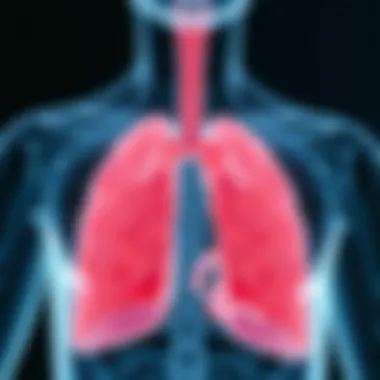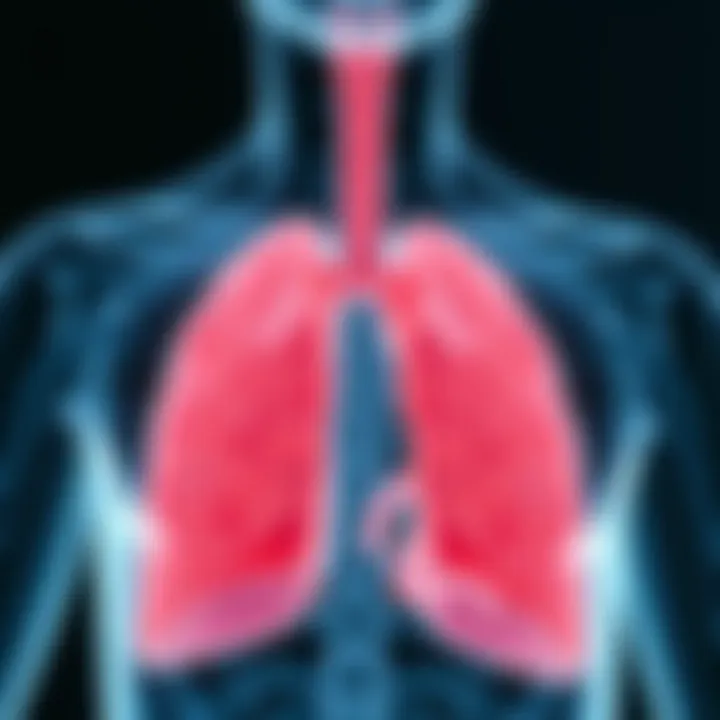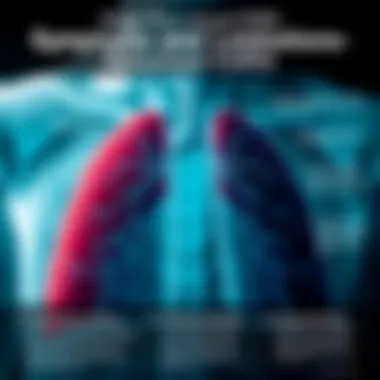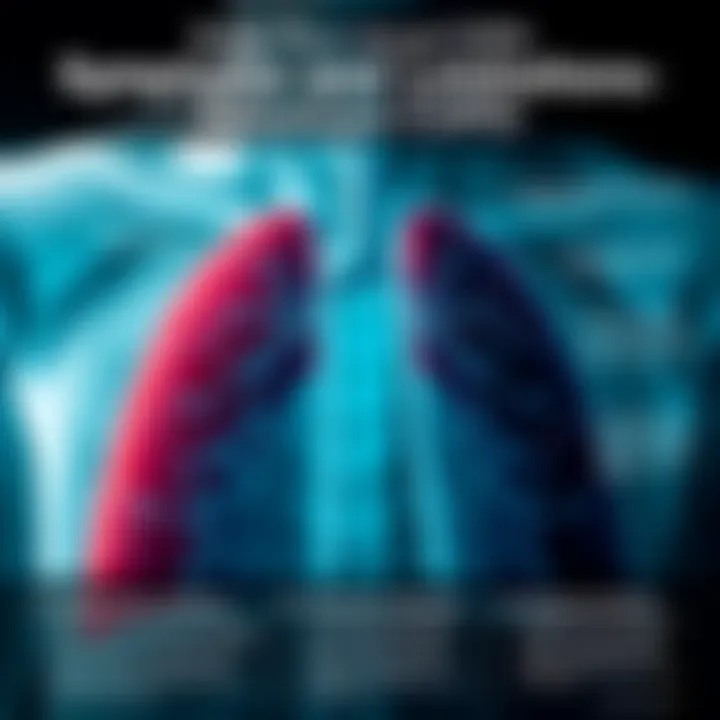Understanding Stage Four COPD: Clinical Impacts


Intro
Chronic obstructive pulmonary disease (COPD) is a term that covers various conditions affecting the lungs, like emphysema and chronic bronchitis. As we look into stage four COPD, it becomes clear this is the stage where the fallout is most pronounced. Patients face considerable challenges, marked by distressing symptoms and limited day-to-day capabilities. In this article, we will unpack the implications and significant impact of stage four COPD, focusing on understanding its intertwined aspects.
Research Context
Background Information
COPD is more than just a respiratory ailment; it holds a significant place in the realm of public health. Stage four, often referred to as very severe COPD, is characterized by a forced expiratory volume (FEV1) that is less than 30% of the predicted value. This can be a real game changer for individuals. Often, they can’t complete tasks that seemed trivial in the past. Breathing can be like trying to suck air through a straw that's been pinched. Life doesn't just take a back seat; it comes to a screeching halt.
Importance of the Study
Understanding stage four COPD is crucial, not only for healthcare providers but also for families, caregivers, and researchers. The goal here isn't just to read numbers off a chart; it’s about acknowledging the human experience behind the diagnoses. By focusing on this specific stage, we can shed light on the myriad effects—both physical and emotional—triggered when managing such a condition. Knowing the implications helps in delivering better patient-centered care, and it might just save a person’s quality of life.
Discussion
Interpretation of Results
When analyzing the progression of COPD, especially to its most advanced stages, it becomes evident that the effects aren’t merely clinical; they echo throughout everyday living. Patients in stage four often face frequent hospitalizations, especially during exacerbations. Literature shows these patients experience heightened feelings of anxiety and depression—often as a direct result of their limited ability to perform everyday tasks. As they struggle with breathlessness, it can feel like an endless cycle of medical appointments and medications.
Comparison with Previous Research
Previous studies have laid the groundwork for understanding the physical limitations of COPD. However, they often skimp on the human side, neglecting aspects like emotional resilience and social interaction. Research by the Global Initiative for Chronic Obstructive Lung Disease (GOLD) highlights the need for more comprehensive frameworks that remove any piecemeal approach. Today, we know that effective management strategies encompass more than just bronchodilators or steroids—it requires an understanding of how COPD impacts one's psyche and social dynamics. The ripple effects are vast, making it vital to view COPD through a multifaceted lens.
"There is no health without mental health." - World Health Organization
Key Points
- Stage four COPD is often linked with significant emotional distress.
- Management approaches should address physical health and mental wellbeing.
- Effective care strategies involve a support system, integrating healthcare providers, family members, and mental health resources.
Foreword to COPD
Chronic Obstructive Pulmonary Disease (COPD) is far more than just a set of symptoms; it's a gradual and relentless decline in lung function that can drastically redefine a person’s life. The significance of understanding COPD lies not only in the medical arena but also in the social and emotional landscape that surrounds it. In this article, we’ll dive deep into the various facets of stage four COPD, emphasizing the importance of awareness, timely diagnosis, and management strategies that can enhance the quality of life for those affected.
The earlier stages of COPD may exhibit mild symptoms, but as the condition progresses, the implications become more severe and complex. Understanding what COPD is and its stages paves the way for effective intervention. Healthcare providers, caregivers, and even the patients themselves must recognize the shifts in their condition. With a deep comprehension of the disease trajectory, they can better navigate the challenges and choices that arise down the line.
Patients with stage four COPD are often faced with significant physical limitations, leading to emotional and psychological hurdles as well. From the effects it has on daily routine activities to the potential complications that can arise, every aspect is crucial to grasp. The aim of this exploration is to unpack these layers, empowering stakeholders with the knowledge they need to manage this debilitating condition effectively.
In essence, this article is designed to not just inform but also to equip individuals with the insights necessary for better living with stage four COPD. It addresses the spectrum of symptoms, available treatments, and support systems that can contribute to a more manageable existence despite the challenges posed by this chronic disease.
Stage Four COPD Overview
Stage Four Chronic Obstructive Pulmonary Disease (COPD) stands as the most critical phase of a relentless respiratory ailment, where the implications and the impact are profound for those affected. This stage marks a pivotal point in patient care, representing not just a deterioration of lung function, but also a significant decline in overall quality of life. The urgency in understanding stage four COPD stems from its far-reaching consequences, not only on the individual but also within family dynamics and healthcare systems. The journey through this late-stage disease encompasses severe respiratory distress, potential co-morbidities, and extensive supportive care needs.
Defining Stage Four COPD
Stage Four COPD is characterized by an extreme limitation in airflow. Individuals often breathe with great difficulty, even during rest, making simple tasks feel Herculean. The Global Initiative for Chronic Obstructive Lung Disease (GOLD) classifies COPD into stages based on the severity of symptoms, and Stage Four is defined by a Forced Expiratory Volume (FEV1) of less than 30% predicted or the presence of respiratory failure. Patients in this stage frequently require supplemental oxygen and may depend on various devices for daily functioning. Understanding this stage is crucial for healthcare providers as it necessitates tailored interventions to manage symptoms and improve life quality.
Prevalence and Epidemiology
According to data from the World Health Organization (WHO), COPD ranks among the leading causes of morbidity and mortality worldwide. Recent studies highlight that approximately 3 million deaths each year are attributed to COPD, and as it progresses, stage four accounts for a substantial portion of these fatalities. However, prevalence rates can vary significantly based on geographic location, socioeconomic status, and access to healthcare services.
- In high-income countries, early diagnosis and intervention can often delay progression, but in low and mid-income regions, the late-stage diagnosis is alarmingly common.
- Additionally, air quality and exposure to pollutants play critical roles in the exacerbation of COPD symptoms, particularly in urban areas.
"Awareness and preventive measures can greatly impact the trajectory of this disease, especially in the early stages."
Given that stage four COPD represents a significant health burden, understanding its epidemiological trends is essential. Healthcare policies must evolve to focus on the prevention and management of COPD at all stages, particularly where disparities exist in access to care. Knowledge of these statistics helps inform public health initiatives aimed at reducing the impact of this devastating disease.
Clinical Manifestations of Stage Four COPD
Understanding the clinical manifestations of stage four COPD is essential for multiple reasons. This stage represents a critical juncture where patients endure significant respiratory challenges that greatly hinder their day-to-day lives. Recognizing and addressing these manifestations not only aids healthcare providers in delivering better care but also empowers patients and families to grasp the reality of living with such a debilitating condition.
Early detection of symptoms can prompt timely interventions, making early recognition pivotal in managing and potentially improving patients' quality of life. The discourse around clinical manifestations thus becomes a bridge to create effective management plans and support systems for individuals contending with this formidable disease.
Symptoms and Their Severity


Breathlessness
Breathlessness, often termed dyspnea, is one of the hallmark symptoms of stage four COPD. This sensation can be both frightening and disorienting, contributing significantly to the patient’s overall distress and lifestyle limitations. The overwhelming shortness of breath can make even simple tasks feel insurmountable, restricting patients to a sedentary mode of existence.
This symptom is critical because it encapsulates the essence of what patients experience daily. Characteristically, breathlessness escalates with exertion and may even occur at rest in advanced stages. This makes it a genuine indicator of how the disease is manifesting in real-time.
Due to its nature, managing breathlessness becomes a priority. Patients may turn to various therapeutic options, such as bronchodilators, to ease their breathing. However, the psychological burden that accompanies breathlessness cannot be overlooked. The fear of choking or gasping for air can lead to anxiety, further exacerbating the symptom and creating a vicious cycle.
Chronic Cough
Chronic cough can feel like an unwelcome companion for those dealing with stage four COPD. This symptom is defined by a cough that persists over time, often producing sputum, which can be taxing on both physical and mental health. Notably, a consistent cough indicates that the respiratory system is working harder than normal, highlighting the underlying respiratory struggles.
The key characteristic of a chronic cough in COPD is its duration and the frequency with which it occurs. It’s not merely a nuisance but rather a compelling sign of a body struggling to clear mucus and maintain airway health. This cough often disturbs sleep patterns, further impacting patients’ energy levels and emotional well-being.
Managing this symptom might involve using expectorants or cough suppressants, although finding the right balance is often a complex task, as suppressing the cough too much might hinder the body’s natural clearing mechanisms.
Sputum Production
Sputum production is another notable symptom in stage four COPD, often serving as an indicator of severity. Those afflicted may notice an increase in the thickness and frequency of sputum, which can be both uncomfortable and embarrassing. The sputum can vary in color and viscosity, providing clinicians with clues about potential infections or exacerbations.
Characteristically, sputum production signifies inflammation and irritation in the airways. This can present an obstacle to clearance – not just physically, but emotionally as well, as patients might feel that they constantly have to deal with this unpleasant side effect of their illness. The challenge is managing this symptom while ensuring that the patient maintains their ability to expel mucus effectively, preventing additional complications like lung infections.
Impact on Daily Activities
Activity Limitations
Activity limitations are a fundamental aspect of living with stage four COPD, changing the fabric of daily living. As breathlessness sets in, doing even the most mundane tasks requires increasing effort and often can provoke a surge of anxiety. Going to the grocery store or even moving from room to room can become monumental challenges.
This symptom can lead to a concerning shift in lifestyle, where individuals tend to withdraw from social interactions and activities they once enjoyed. The psychological impact cannot be overstated, as restricted physical capabilities often contribute to feelings of boredom, irritability, and depression, creating a spiral of isolation.
Healthcare providers must be cognizant of these limitations to tailor interventions that encourage manageable physical activity, fostering a sense of accomplishment and well-being.
Fatigue and Weakness
Fatigue and weakness are common companions of advanced COPD. When a person's body works excessively hard to breathe, it depletes energy reserves, leaving individuals drained and less able to engage in their typical routines. This fatigue closely intertwines with breathlessness, as more effort generally leads to increased exhaustion.
The key feature of fatigue in this context isn’t just the tiredness but the overwhelming sensation of depleted resources, both physically and emotionally. Patients may often feel like they're running on empty, complicating their ability to partake in previously enjoyable activities. This fatigue may also blur the lines as it affects concentration and mood, creating a snowball effect on overall quality of life.
To combat fatigue, strategies like pacing oneself and integrating short rest periods throughout the day are often recommended. However, recognizing that the accompanying weakness is a direct consequence of their illness is crucial for both patients and caregivers alike.
In summary, understanding the clinical manifestations of stage four COPD provides profound insight into managing the disease effectively. This knowledge serves as a foundation for discussions around treatment and support, enabling the navigation of daily life with an empowered and informed approach.
Diagnosis of Stage Four COPD
Diagnosing stage four COPD is of utmost significance, as it represents the final and most debilitating phase of the disease, characterized by extreme limitations in airflow and severe symptoms. Timely and accurate diagnoses can greatly influence treatment options, management strategies, and patient prognosis. Moreover, understanding the medical criteria used for this diagnosis helps healthcare providers better tailor their approach to meet individual patient needs. Identifying this stage also invites discussions regarding end-of-life considerations and palliative care, assisting patients and their families to navigate difficult choices proactively.
The diagnostic process for stage four COPD typically involves several key components, including detailed pulmonary function tests and advanced imaging techniques. These methods not only help confirm the disease's presence but also clarify its severity, establishing a foundation for effectively managing the condition. In the next sections, we will delve into these diagnostic criteria, outlining their individual roles and contributions.
Diagnostic Criteria
Pulmonary Function Tests
Pulmonary function tests (PFTs) are crucial in diagnosing stage four COPD. These tests measure airflow limitations and lung capacity, providing clear evidence of the respiratory impairment characteristic of this stage. One fundamental aspect of PFTs is their ability to quantify airflow obstruction through metrics such as the forced expiratory volume (FEV1) and the forced vital capacity (FVC).
The key characteristic of PFTs lies in its objective nature, making it a favored choice among healthcare professionals. They deliver precise numerical data that help in determining not only the presence of COPD but also its severity. The unique feature of these tests is their non-invasive method, usually performed in an outpatient setting, allowing patients to undergo testing without significant disruption to their daily lives.
However, while PFTs bring about numerous advantages, such as clear benchmarks for treatment response, there are some disadvantages to consider. Some patients may misinterpret the performance of these tests due to anxiety, leading to potentially confusing results. Additionally, factors like age, sex, and height could skew outcomes, emphasizing the need for proper interpretation by seasoned professionals.
Imaging Techniques
Imaging techniques play an integral role in diagnosing stage four COPD, providing visual insights into the patient's lung structure. High-resolution computed tomography (HRCT) scans are particularly useful in this context, highlighting the physical changes occurring in the lungs due to ongoing damage.
The key characteristic of imaging techniques is their ability to reveal complications or co-morbidities that may not be apparent through PFTs alone. HRCT scans, for instance, can identify emphysema or bronchiectasis, conditions that often coexist with COPD and can significantly influence management strategies. This makes imaging an invaluable tool in the diagnostic arsenal for stage four COPD.
In terms of unique features, imaging allows healthcare providers to visualize damage at a cellular level. This can be pivotal in understanding the patient's condition and sculpting a personalized treatment plan. However, the downside lies in the potential for over-reliance. While imaging provides essential information, it should not be the sole basis for diagnosing COPD; it has limitations, such as exposure to radiation and the possible financial burden for some patients.
Differential Diagnosis


Differential diagnosis is essential when assessing stage four COPD, as the symptoms can overlap significantly with other respiratory diseases like asthma, bronchiectasis, and pulmonary fibrosis. It is crucial to distinguish between these conditions to ensure that appropriate interventions are employed. Healthcare providers must take into account patient history, symptom development, and environmental factors that may contribute to the clinical picture. Ultimately, achieving an accurate diagnosis forms the cornerstone for effective management and improved patient outcomes.
Complications Associated with Stage Four COPD
Stage four COPD is not just a respiratory ailment; it’s a battle against multiple health complications that can arise from its existence. This stage of the disease evokes not only the physical symptoms but also the interconnectedness of other serious health conditions that can greatly impact a patient’s quality of life. Understanding these complications offers vital insights for both medical professionals and caregivers. By spotlighting the co-morbidities and acute exacerbations associated with stage four COPD, we can help create a more holistic approach to management and care.
Co-Morbid Conditions
Cardiovascular Diseases
Cardiovascular diseases are a notable concern associated with stage four COPD. The chronic inflammation in the lungs can lead to increased heart strain, affecting circulation and overall cardiovascular health. Patients facing the dual challenge of COPD and heart disease often find themselves in a precarious position where managing both conditions becomes crucial.
One key characteristic of cardiovascular diseases in this context is the increased risk for heart attacks or strokes, which arise from reduced oxygen levels in the blood due to compromised lung function. This connection underscores why it is pertinent to understand these risks, as each patient may exhibit unique symptoms or respond differently to treatments specifically tailored for their cardiovascular health. Many patients with severe COPD also experience heart failure, highlighting the importance of vigilant monitoring and treatment adjustments that address both respiratory and cardiac issues.
Incorporating cardiovascular assessments into the care strategy for COPD patients can lead to better outcomes. It’s not merely advantageous; it's essential in navigating the complexities of disease management. This integration provides a broader perspective on the patient’s health, emphasizing the need for interdisciplinary efforts between pulmonologists and cardiologists.
Respiratory Infections
Another significant aspect of complications in stage four COPD is the susceptibility to respiratory infections. With weakened lung function, COPD patients face an elevated risk for conditions such as pneumonia and bronchitis. These infections can exacerbate the existing lung impairment, leading to a detrimental cycle that further restricts breathing and overall wellness.
The key characteristic of respiratory infections in this stage is their tendency to escalate quickly. A simple cold can turn into a severe infection, necessitating hospitalization and more aggressive treatment. Understanding this relationship is crucial; it highlights why vaccination against diseases like influenza and pneumonia is often recommended for individuals with advanced COPD. By avoiding infections, patients can maintain their lung function for a longer period, thereby improving their overall quality of life. The unique feature here is the proactive measures that can be implemented—early recognition and prompt treatment can mitigate the severity of infections, offering patients a fighting chance against complications.
Acute Exacerbations
Acute exacerbations represent significant spikes in the severity of COPD symptoms, often requiring immediate medical attention. These flare-ups can lead to hospitalization as they result in a dramatic increase in breathlessness, cough, and sputum production. Understanding the triggers—be it infections, environmental factors, or neglecting medication—can empower patients and their healthcare teams to implement timely interventions.
The repercussions of these exacerbations extend beyond immediate health concerns. They can lead to increased emotional distress, affecting mental health and altering daily living. Thus, understanding both the physical and psychological implications of these acute events is paramount in delivering comprehensive care to stage four COPD patients.
Management Strategies for Stage Four COPD
Effective management strategies for stage four chronic obstructive pulmonary disease (COPD) are crucial in improving the quality of life for individuals grappling with this debilitating condition. The significance of these strategies lies not only in alleviating symptoms but also in enhancing overall health and well-being. This phase of COPD often results in severe limitations, and addressing both pharmacological and non-pharmacological approaches can lead to better outcomes. Importantly, proper management can help patients maintain some semblance of normalcy in their daily activities.
Pharmacological Interventions
Bronchodilators
Bronchodilators are central to the medical management of stage four COPD. These medications work by relaxing the muscles around the airways, effectively widening them and permitting better airflow. A notable feature of bronchodilators is their quick-acting nature; many patients find relief within moments of use. Moreover, they can be categorized into two groups: short-acting and long-acting, allowing flexibility based on the day-to-day needs of the patient.
One substantial benefit of bronchodilators is their ability to reduce symptoms, which can significantly improve a patient's ability to engage in activities. However, it's worth noting that they may not be effective for everyone, and some individuals might experience side effects like increased heart rate or tremors. Pairing bronchodilators with appropriate lifestyle adjustments may enhance their effectiveness.
Corticosteroids
Corticosteroids are another essential component of medical treatment for stage four COPD. These medications serve as potent anti-inflammatory agents, reducing swelling in the airways and providing relief. They are particularly beneficial in preventing acute exacerbations, which are critical in this advanced stage of COPD.
A key characteristic of corticosteroids is their long-term use, which aids in managing chronic inflammation. Yet, while they are widely considered beneficial, they also come with their fair share of drawbacks; potential side effects such as weight gain or osteoporosis may occur, especially when taken over extended periods. Thus, careful monitoring and dosage adjustments are important for overweighting the benefits and limiting side effects.
Non-Pharmacological Approaches
Pulmonary Rehabilitation
Pulmonary rehabilitation is a cornerstone of COPD management, especially for patients in stage four. This multifaceted approach combines physical exercise, education, and emotional support tailored to individual needs. By enhancing physical endurance and improving respiratory function, pulmonary rehabilitation can play a transformative role.
The vital aspect of this program is the structured exercise components, which aim to improve muscle strength and reduce breathlessness during daily activities. One unique feature is the psycho-social support embedded in these programs, often helping individuals cope with feelings of isolation or anxiety. However, commitment to a rehabilitation program may be challenging for some due to fatigue and mobility limitations. Nevertheless, the potential for improving lung function and overall quality of life makes this approach invaluable.
Supplemental Oxygen Therapy
Supplemental oxygen therapy is often necessary for patients experiencing severe hypoxemia, or low oxygen levels, associated with stage four COPD. This therapy involves administering oxygen to enhance oxygen saturation levels, thus boosting overall respiratory efficiency. The primary goal is clear: to enable individuals to breathe more comfortably and perform daily activities with less fatigue.
One primary characteristic of supplemental oxygen therapy is its adaptability; it can be delivered via various devices to suit the patient's lifestyle, whether in-home, during exercise, or even while traveling. However, reliance on oxygen therapy can sometimes create a psychological burden, as individuals navigate their dependence on equipment in daily life. Balancing the therapy with a positive mindset about one’s health becomes pivotal.
Ultimately, the management of stage four COPD must encompass both pharmacological and non-pharmacological strategies tailored to individual needs, ensuring a comprehensive approach to patient care. The effectiveness of these strategies hinges on collaborative dialogue between healthcare providers and patients, fostering an environment conducive to adaptation and resilience.
Psychosocial Implications of Living with Stage Four COPD
Living with Stage Four COPD can feel like a heavy burden, not just physically but emotionally as well. As individuals navigate the limitations of their condition, they are often faced with a multitude of psychosocial challenges that can substantially affect their lives. Understanding these implications is crucial for both patients and caregivers, as it helps provide better support and fosters a more holistic approach to care.
Mental Health Challenges


Depression
Depression in the context of Stage Four COPD is particularly prominent. With the looming presence of chronic symptoms and increasing dependency on others, many patients may feel a profound sense of hopelessness. A key characteristic of depression is the persistent feeling of sadness or loss of interest in activities once enjoyed. This emotional state can be exacerbated by the isolation often experienced in later stages of COPD.
A unique feature of depression is how it can heavily influence the patient's engagement in their treatment plan, ultimately affecting their overall health outcomes. When individuals are caught in the grip of despair, they may neglect their medications or resist necessary lifestyle changes. Recognizing the signs of depression ensures timely intervention and could lead to significant improvements in quality of life. Therefore, addressing depression is not just beneficial; it is crucial.
Anxiety Disorders
Similarly, anxiety disorders can emerge as significant barriers for those with Stage Four COPD. Living with such a limiting illness often invites a cascade of worries about health status, mortality, and the ability to perform daily tasks. The key characteristic of anxiety disorders is a pervasive state of worry or fear that can be debilitating. As individuals face the realities of their illness, anxiety can act like a shadow, lurking and intensifying even the simplest activities.
In this article, anxiety disorders are acknowledged not only for their prevalence but also for their unique characteristics. For instance, anxiety can create a feedback loop where fear of breathlessness intensifies the very symptoms being feared. This can lead to a cycle that's hard to break. Interventions that target anxiety among COPD patients can foster resilience and enhance coping strategies, highlighting their undeniable importance in comprehensive care strategies.
Support Systems
Family and Caregiver Support
The role of family and caregivers in managing Stage Four COPD can’t be overstated. Family support provides not only a safety net but also emotional and physical assistance. A crucial aspect of this support system is the sense of belonging and shared understanding that families can offer. When patients feel the presence and backing of their family, they are more likely to stay engaged with their treatment regimens.
Unique to this environment, family members often become advocates for the patient, helping navigate healthcare complexities while providing essential encouragement during difficult times. But it’s important to highlight that family caregivers themselves may face challenges, which could make the dynamics of support complex. Acknowledging their needs too is vital for the health of both parties, as burnout can affect the quality of care provided.
Community Resources
Community resources play a pivotal role in the lives of those with Stage Four COPD. These resources can range from support groups to local health programs, each contributing to a broader safety net. A key characteristic of community resources is their accessibility; thus, they can help reduce feelings of isolation that often accompany such debilitating conditions.
An essential feature of these resources is their ability to connect patients with others who are in similar situations. This can impart a sense of shared experience, making challenges feel a bit less formidable. Additionally, community resources may offer educational workshops that help patients manage their condition more effectively. Yet, there can be disadvantages if these resources are not adequately promoted or accessible, as individuals may not be aware of the help available. Recognizing and utilizing these community assets can significantly enhance the psychosocial well-being and overall quality of life for individuals living with Stage Four COPD.
Understanding the psychosocial components of living with Stage Four COPD is not just optional; it's essential for fostering comprehensive care that addresses not only physical limitations but emotional needs as well.
End-of-Life Considerations
Considering the implications of end-of-life care in individuals diagnosed with stage four chronic obstructive pulmonary disease (COPD) is crucial for both patients and their healthcare providers. This stage of COPD often brings about significant changes in the way individuals experience their daily lives, with a marked deterioration in lung function and overall health. Addressing end-of-life considerations facilitates a dignified transition for those affected, ensuring that their preferences and values are honored.
Palliative Care Options
Palliative care focuses on providing relief from symptoms and stress, irrespective of the stage of the disease. For those facing stage four COPD, this can mean a significant improvement in quality of life. Key elements of palliative care options include:
- Symptom Management: Managing breathlessness, pain, anxiety, and depression is vital. Opioids might be used to relieve severe breathlessness, while antidepressants could help with mood disorders.
- Multidisciplinary Approach: Engaging a team of healthcare professionals, including doctors, nurses, social workers, and therapists, can create a more comprehensive care strategy tailored to the individual's needs.
- Support for Family Members: Palliative care not only addresses the individual's needs but also offers support for family members who may be grappling with distress or caregiving demands. Resources can include counseling, which is paramount in helping loved ones cope with their emotional experiences.
“Palliative care is not about giving up hope; it's about enhancing life while managing difficult symptoms.”
The benefits of opting for palliative care can be profound, extending beyond mere physical health. It often enhances emotional well-being, allowing individuals to maintain relationships, partake in valued activities, and find peace in their decisions. Through good communication channels, end-of-life wishes can be clarified, thereby aligning the care received with the patient’s values.
Advanced Care Planning
Advanced care planning is about making decisions today that will guide future care preferences when the individual may no longer be able to speak for themselves. In the context of stage four COPD, such discussions can take on various dimensions:
- Living Wills and Healthcare Proxy: Formalizing wishes through a living will ensures that individuals' preferences regarding treatments, resuscitations, and interventions are clearly articulated.
- Regular Conversations: It's important for patients to have ongoing dialogues with healthcare providers, family, and friends about their desires regarding end-of-life care. This promotes understanding, and can lead to better support in time of need.
- Emphasis on Goals of Care: Patients should contemplate what is most important to them, whether that means focusing on comfort, longevity, or specific life experiences. This also includes discussions about goals of care with various medical teams to ensure that desired pathways are respected.
Ultimately, advanced care planning empowers individuals to steer their health care journey, ensuring that it aligns with their beliefs and values. This proactive approach not only provides peace of mind for patients but also alleviates stress for family members making difficult decisions later on.
By integrating robust palliative care and thorough advanced care planning into the discussion surrounding end-of-life considerations, we foster a compassionate approach that respects the journey of those living with stage four COPD.
Epilogue
Navigating the complexities of Stage Four COPD is a vital endeavor, particularly when it comes to understanding the implications and impacts on patients’ lives. This severe stage of chronic obstructive pulmonary disease is characterized by profound functional limitations and symptoms that can significantly diminish quality of life. Raising awareness around this topic is not just an academic exercise; it has real-world implications for healthcare providers, caregivers, and individuals facing this challenging condition.
The importance of this conclusion lies in a few critical areas:
- Patient Care: A thorough grasp of the clinical manifestations, management strategies, and psychosocial aspects enables healthcare professionals to craft personalized care plans. Addressing both medical needs and emotional support can lead to improved outcomes.
- Education and Awareness: For students and educators alike, understanding Stage Four COPD facilitates discussions around chronic illness management, which is essential in fostering empathetic care practices. This knowledge equips future professionals to better advocate for patients.
- Future Challenges: The conclusion also serves to remind us that the landscape of COPD management is ever-evolving. Continued research is essential to advance therapeutic options and improve patient support systems.
Thus, solidifying our understanding of Stage Four COPD is paramount. As we turn to the next section, a summary of key points will encapsulate the information delved into, reinforcing our insights.
Summary of Key Points
- Stage Four COPD is the most severe form of the disease, entailing critical airflow limitations and significant symptoms.
- Key clinical manifestations include breathlessness and chronic cough, which interfere with daily activities and overall quality of life.
- Medical management involves both pharmacological interventions such as bronchodilators and corticosteroids, as well as non-pharmacological approaches like pulmonary rehabilitation.
- Psychological effects such as anxiety and depression are prevalent among patients, highlighting the need for comprehensive support systems.
- End-of-life considerations, including palliative care and advanced care planning, are crucial for enhancing patient dignity and comfort.
Future Directions in Research and Care
Looking forward, it is imperative to focus research efforts on several key areas related to Stage Four COPD:
- Innovative Treatments: There is ongoing exploration into novel pharmaceutical agents and delivery methods that could enhance the effectiveness of existing COPD treatments. These advancements might yield better symptom control and improved breathing capacity.
- Technological Integration: The role of technology in managing COPD cannot be understated. Telehealth services and remote monitoring tools offer promising avenues for patient support and self-management, allowing for real-time adjustments in care based on individual needs.
- Holistic Approaches: Emphasizing integrated care models that prioritize physical, mental, and social health could transform the quality of life for patients living with COPD. Expanding research into additional therapeutic techniques such as mindfulness and emotional resilience training could further support this expansive view of patient care.
In summary, synthesizing the knowledge gleaned from research and clinical experiences is essential in crafting effective strategies to combat Stage Four COPD. This multifaceted approach will not only uplift patients but also pave the way for future breakthroughs in care and support.















